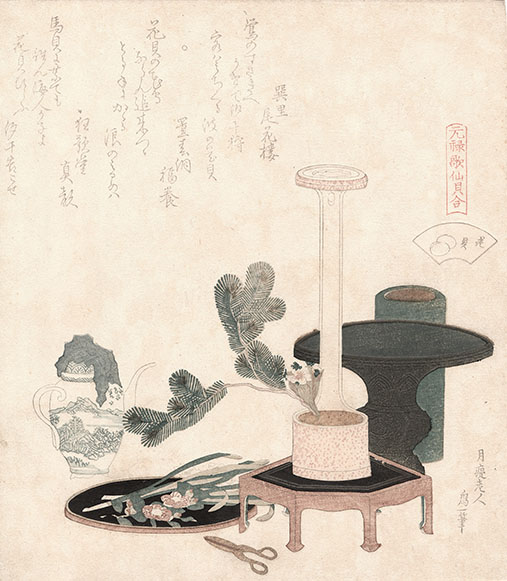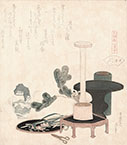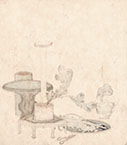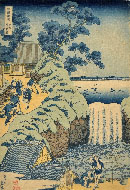(1760 - 1849)
THE FLOWER SHELL (Hanagai): STILL LIFE WITH FLOWER ARRANGEMENT, 1821
Colour woodblock print, shikishiban surimono from the series A Matching Game with the Genroku Poem Shells (Genroku Kasen kaiawase), 1821. Signed Getchirojin Itsu hitsu. The three poems are about gathering shells in the flower-like waves.
Very good impression with silver and gold partly retained. See here an image of both recto and verso; 205 x 180 mm.
The series, commissioned to Hokusai by the Yomogawa group of poets, refers to a few collections of poems associated with shells, published around 1689, at the beginning of the Genroku period. This series has been thoroughly studied. See Matthi Forrer and Roger Keyes, Very like a Whale? - Hokusai's Illustrations for the Genroku Poem Shells, in A Sheaf of Japanese Papers in Tribute to Heinz Kaempfer on his 75th Birthday. Edited by Matthi Forrer, Willelm R. van Gulik, Jack Hillier, Society for Japanese Arts and Crafts, The Hague, 1979.
Other specimens of this print have been exhibited and published. I mention only a few: Gerhard Schack, Surimono: Japanische Gluckwunschblatter aus der Sammlung Gerhard Schack, catalogue of the exhibition in Lübeck, Hamburg 1969; no. 75, illustrated.
Les Objets Tranquilles : Natures Mortes Japonaises Xviiie-Xixe Siècles, catalogue of the exhibition at the Janet Ostier Gallery, Paris 1978; no. 29, illustrated.
Rijksprentenkabinet, Hokusai and his School: Japanese Prints, c. 1800-1840. (Catalogue of the Collection of Japanese Prints. 3), Amsterdam 1982; no. 232, illustrated.
The impression at the Rijksprentenkabinet is visible online.
Hokusai was the greatest of all the Japanese painters of Ukiyo-e. He was a voracious student of a huge range of artistic techniques and his work covered a spectrum of art forms: polychrome or ink paintings; surimono (de luxe, small-edition woodblock prints) and polychrome prints; woodblocks for all kind of illustrated books; erotic pictures. Hokusai is thought to have made in all at least 30,000 drawings and the illustrations for 500 books. He led a life of singular variety, sustained by his inexhaustible energy.




